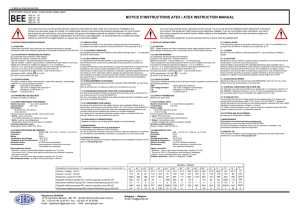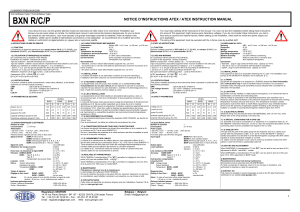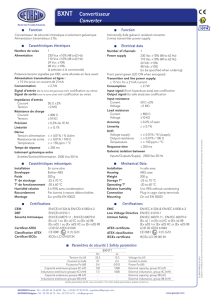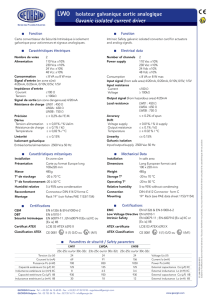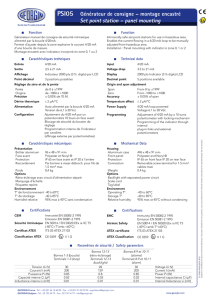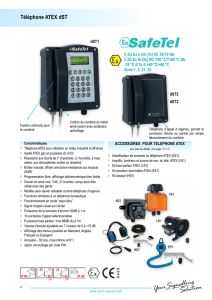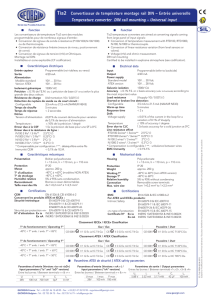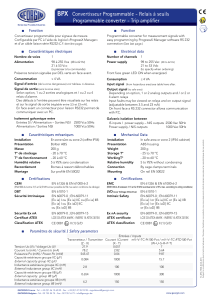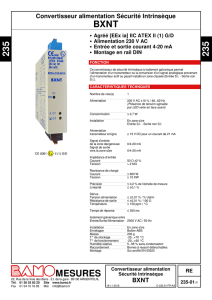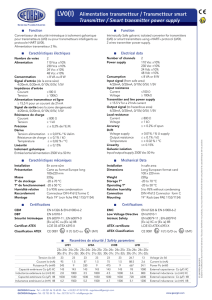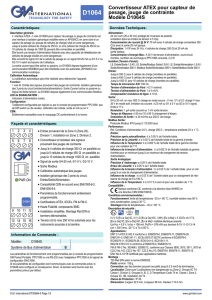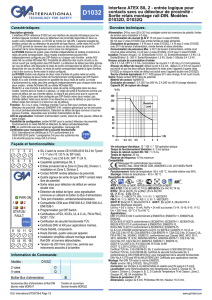ATEX INSTRUCTION MANUAL / NOTICE D`INSTRUCTIONS ATEX
publicité
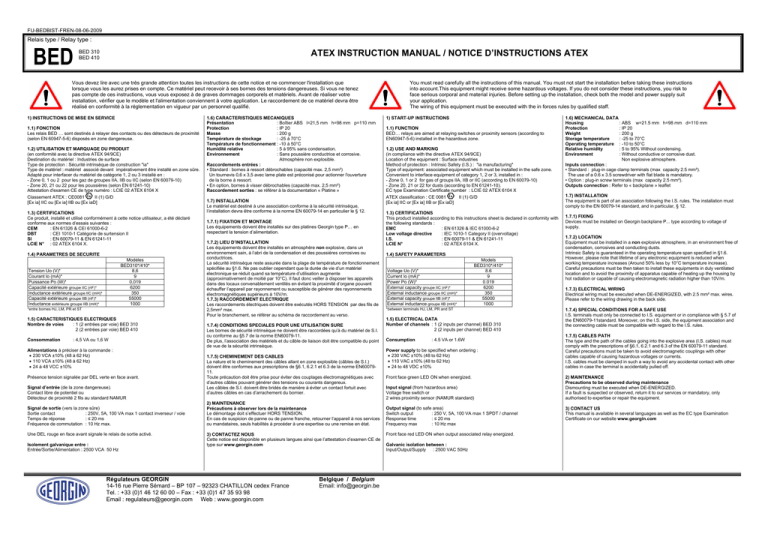
FU-BEDBIST-FREN-08-06-2009 Relais type / Relay type : BED BED 310 BED 410 ATEX INSTRUCTION MANUAL / NOTICE D’INSTRUCTIONS ATEX Vous devez lire avec une très grande attention toutes les instructions de cette notice et ne commencer l'installation que lorsque vous les aurez prises en compte. Ce matériel peut recevoir à ses bornes des tensions dangereuses. Si vous ne tenez pas compte de ces instructions, vous vous exposez à de graves dommages corporels et matériels. Avant de réaliser votre installation, vérifier que le modèle et l'alimentation conviennent à votre application. Le raccordement de ce matériel devra être réalisé en conformité à la réglementation en vigueur par un personnel qualifié. 1) INSTRUCTIONS DE MISE EN SERVICE 1.1) FONCTION Les relais BED … sont destinés à relayer des contacts ou des détecteurs de proximité (selon EN 60947-5-6) disposés en zone dangereuse. 1.2) UTILISATION ET MARQUAGE DU PRODUIT (en conformité avec la directive ATEX 94/9CE) Destination du matériel : Industries de surface Type de protection : Sécurité intrinsèque de construction "ia" Type de matériel : matériel associé devant impérativement être installé en zone sûre. Adapté pour interfacer du matériel de catégorie 1, 2 ou 3 installé en : - Zone 0, 1 ou 2 pour les gaz de groupes IIA, IIB ou IIC (selon EN 60079-10) - Zone 20, 21 ou 22 pour les poussières (selon EN 61241-10) Attestation d'examen CE de type numéro : LCIE 02 ATEX 6104 X II (1) G/D Classement ATEX : CE0081 [Ex ia] IIC ou [Ex ia] IIB ou [Ex iaD] 1.3) CERTIFICATIONS Ce produit, installé et utilisé conformément à cette notice utilisateur, a été déclaré conforme aux normes d’essais suivantes : CEM : EN 61326 & CEI 61000-6-2 DBT : CEI 1010-1 Catégorie de surtension II SI : EN 60079-11 & EN 61241-11 LCIE N° : 02 ATEX 6104 X. 1.4) PARAMETRES DE SECURITE Modèles BED310*/410* 8,6 9 0,019 6200 350 55000 1000 Tension Uo (V)* Courant lo (mA)* Puissance Po (W)* Capacité extérieure groupe IIC (nF)* Inductance extérieure groupe IIC (mH)* Capacité extérieure groupe IIB (nF)* Inductance extérieure groupe IIB (mH)* *entre bornes HJ, LM, PR et ST 1.5) CARACTERISTIQUES ELECTRIQUES Nombre de voies : 1 (2 entrées par voie) BED 310 2 (2 entrées par voie) BED 410 Consommation : 4,5 VA ou 1,6 W Alimentations à préciser à la commande : • 230 VCA ±10% (48 à 62 Hz) • 110 VCA ±10% (48 à 62 Hz) • 24 à 48 VCC ±10% Présence tension signalée par DEL verte en face avant. Signal d’entrée (de la zone dangereuse). Contact libre de potentiel ou Détecteur de proximité 2 fils au standard NAMUR Signal de sortie (vers la zone sûre) Sortie contact : 250V, 5A, 100 VA max 1 contact inverseur / voie Temps de réponse : ≤ 20 ms Fréquence de commutation : 10 Hz max. Une DEL rouge en face avant signale le relais de sortie activé. Isolement galvanique entre : Entrée/Sortie/Alimentation : 2500 VCA 50 Hz 1.6) CARACTERISTIQUES MECANIQUES Présentation : Boîtier ABS l=21,5 mm h=98 mm p=110 mm Protection : IP 20 Masse : 200 g Température de stockage : -25 à 70°C Température de fonctionnement : -10 à 50°C Humidité relative : 5 à 95% sans condensation. Environnement : Sans poussière conductrice et corrosive. Atmosphère non explosible. Raccordements entrées : • Standard : bornes à ressort débrochables (capacité max. 2,5 mm²) Un tournevis 0,6 x 3,5 avec lame plate est préconisé pour actionner l'ouverture de la borne à ressort. • En option, bornes à visser débrochables (capacité max. 2,5 mm²) Raccordement sorties : se référer à la documentation « Platine » 1.7) INSTALLATION Le matériel est destiné à une association conforme à la sécurité intrinsèque, l’installation devra être conforme à la norme EN 60079-14 en particulier le § 12. 1.7.1) FIXATION ET MONTAGE Les équipements doivent être installés sur des platines Georgin type P… en respectant la tension d’alimentation. 1.7.2) LIEU D’INSTALLATION Les équipements doivent être installés en atmosphère non explosive, dans un environnement sain, à l’abri de la condensation et des poussières corrosives ou conductrices. La sécurité intrinsèque reste assurée dans la plage de température de fonctionnement spécifiée au §1.6. Ne pas oublier cependant que la durée de vie d’un matériel électronique se réduit quand sa température d’utilisation augmente (approximativement de moitié par 10°C). Il faut donc veiller à disposer les appareils dans des locaux convenablement ventilés en évitant la proximité d’organe pouvant échauffer l’appareil par rayonnement ou susceptible de générer des rayonnements électromagnétiques supérieurs à 10V/m. 1.7.3) RACCORDEMENT ELECTRIQUE Les raccordements électriques doivent être exécutés HORS TENSION par des fils de 2,5mm² max. Pour le branchement, se référer au schéma de raccordement au verso. 1.7.4) CONDITIONS SPECIALES POUR UNE UTILISATION SURE Les bornes de sécurité intrinsèque ne doivent être raccordées qu’à du matériel de S.I. ou conforme au §5.7 de la norme EN60079-11. De plus, l’association des matériels et du câble de liaison doit être compatible du point de vue de la sécurité intrinsèque. 1.7.5) CHEMINEMENT DES CABLES La nature et le cheminement des câbles allant en zone explosible (câbles de S.I.) doivent être conformes aux prescriptions de §6.1, 6.2.1 et 6.3 de la norme EN6007911. Toute précaution doit être prise pour éviter des couplages électromagnétiques avec d’autres câbles pouvant générer des tensions ou courants dangereux. Les câbles de S.I. doivent être bridés de manière à éviter un contact fortuit avec d’autres câbles en cas d’arrachement du bornier. 2) MAINTENANCE Précautions à observer lors de la maintenance Le démontage doit s’effectuer HORS TENSION. En cas de suspicion de panne ou de panne franche, retourner l’appareil à nos services ou mandataires, seuls habilités à procéder à une expertise ou une remise en état. 3) CONTACTEZ NOUS Cette notice est disponible en plusieurs langues ainsi que l’attestation d’examen CE de type sur www.georgin.com Régulateurs GEORGIN 14-16 rue Pierre Sémard – BP 107 – 92323 CHATILLON cedex France Tel. : +33 (0)1 46 12 60 00 – Fax : +33 (0)1 47 35 93 98 Email : [email protected] Web : www.georgin.com Belgique / Belgium Email: [email protected] You must read carefully all the instructions of this manual. You must not start the installation before taking these instructions into account.This equipment might receive some hazardous voltages. If you do not consider these instructions, you risk to face serious corporal and material injuries. Before setting up the installation, check both the model and power supply suit your application. The wiring of this equipment must be executed with the in forces rules by qualified staff. 1) START-UP INSTRUCTIONS 1.1) FUNCTION BED… relays are aimed at relaying switches or proximity sensors (according to EN60947-5-6) installed in the hazardous zone. 1.2) USE AND MARKING (in compliance with the directive ATEX 94/9CE) Location of the equipment : Surface industries Method of protection : Intrinsic Safety (I.S.) : "ia manufacturing" Type of equipment: associated equipment which must be installed in the safe zone. Convenient to interface equipment of category 1, 2 or 3, installed in : - Zone 0, 1 or 2 for gas of groups IIA, IIB or IIC (according to EN 60079-10) - Zone 20, 21 or 22 for dusts (according to EN 61241-10). EC type Examination Certificate number : LCIE 02 ATEX 6104 X ATEX classification : CE 0081 [Ex ia] IIC or [Ex ia] IIB or [Ex iaD] II (1) G/D 1.3) CERTIFICATIONS This product installed according to this instructions sheet is declared in conformity with the following standards : EMC : EN 61326 & IEC 61000-6-2 Low voltage directive : IEC 1010-1 Category II (overvoltage) I.S. : EN 60079-11 & EN 61241-11 LCIE N° : 02 ATEX 6104 X. 1.4) SAFETY PARAMETERS Voltage Uo (V)* Current lo (mA)* Power Po (W)* External capacity groupe IIC (nF)* External inductance groupe IIC (mH)* External capacity groupe IIB (nF)* External inductance groupe IIB (mH)* Models BED310*/410* 8.6 9 0.019 6200 350 55000 1000 *between terminals HJ, LM, PR and ST 1.5) ELECTRICAL DATA Number of channels : 1 (2 inputs per channel) BED 310 2 (2 inputs per channel) BED 410 Consumption : 4.5 VA or 1.6W Power supply to be specified when ordering : • 230 VAC ±10% (48 to 62 Hz) • 110 VAC ±10% (48 to 62 Hz) • 24 to 48 VDC ±10% Front face green LED ON when energized. Input signal (from hazardous area) Voltage free switch or 2 wires proximity sensor (NAMUR standard) Output signal (to safe area) Switch output : 250 V, 5A, 100 VA max 1 SPDT / channel Response time : ≤ 20 ms Frequency max : 10 Hz max Front face red LED ON when output associated relay energized. Galvanic isolation between : Input/Output/Supply : 2500 VAC 50Hz 1.6) MECHANICAL DATA Housing : ABS w=21.5 mm h=98 mm d=110 mm Protection : IP 20 Weight : 200 g Storage temperature : -25 to 70°C Operating temperature : -10 to 50°C Relative humidity : 5 to 95% Without condensing. Environment : Without conductive or corrosive dust. Non explosive atmosphere. Inputs connection : • Standard : plug-in cage clamp terminals (max capacity 2.5 mm²). The use of a 0.6 x 3.5 screwdriver with flat blade is mandatory. • Option : plug-in screw terminals (max capacity 2.5 mm²). Outputs connection : Refer to « backplane » leaflet 1.7) INSTALLATION The equipment is part of an association following the I.S. rules. The installation must comply to the EN 60079-14 standard, and in particular, § 12. 1.7.1) FIXING Devices must be installed on Georgin backplane P... type according to voltage of supply. 1.7.2) LOCATION Equipment must be installed in a non explosive atmosphere, in an environment free of condensation, corrosives and conducting dusts. Intrinsic Safety is guaranteed in the operating temperature span specified in §1.6. However, please note that lifetime of any electronic equipment is reduced when working temperature increases (Around 50% less by 10°C temperature increase). Careful precautions must be then taken to install these equipments in duly ventilated location and to avoid the proximity of apparatus capable of heating up the housing by hot radiation or capable of causing electromagnetic radiation higher than 10V/m. 1.7.3) ELECTRICAL WIRING Electrical wiring must be executed when DE-ENERGIZED, with 2.5 mm² max. wires. Please refer to the wiring drawing in the back side. 1.7.4) SPECIAL CONDITIONS FOR A SAFE USE I.S. terminals must only be connected to I.S. equipment or in compliance with § 5.7 of the EN60079-11standard. Moreover, on the I.S. side, the equipment association and the connecting cable must be compatible with regard to the I.S. rules. 1.7.5) CABLES PATH The type and the path of the cables going into the explosive area (I.S. cables) must comply with the prescriptions of §6.1, 6.2.1 and 6.3 of the EN 60079-11 standard. Careful precautions must be taken to avoid electromagnetic couplings with other cables capable of causing hazardous voltages or currents. I.S. cables must be clamped in such a way to avoid any accidental contact with other cables in case the terminal is accidentally pulled off. 2) MAINTENANCE Precautions to be observed during maintenance Dismounting must be executed when DE-ENERGIZED. If a fault is suspected or observed, return it to our services or mandatory, only authorised to expertise or repair the equipment. 3) CONTACT US This manual is available in several languages as well as the EC type Examination Certificate on our website www.georgin.com BED 310/410 ENCOMBREMENT / DIMENSIONS (mm) RACCORDEMENT / WIRING COMMANDE PAR DETECTEUR DE PROXIMITE COMMANDE PAR CONTACT A L’OUVERTURE PROXIMITY SWITCH CONTROL NORMALLY CLOSED SWITCH CONTROL 3 3 1 1 4 2 2 E1 CODIFICATION Modèle / Model Option E2 Exemple : Alimentation Power supply 4 E1 E1 : Détecteur de vanne ouverte / opened valve detector E2 : Détecteur de vanne fermée / closed valve detector DRAPEAU EN POSITION BED 310 2 entrées / 1 sortie 2 inputs / 1 output 410 4 entrées / 2 sorties 4 inputs / 2 outputs 00 Sans option/ Without option 0 230 VAC B0 Bornes à visser/ Screw terminals 1 110 VAC 2 24/48 VDC E2 FLAG IN POSITION 1 relais de sortie au repos (ouverture de la vanne) 1 output relay off (opening of the valve) 2 relais de sortie au travail (vanne ouverte) 2 output relay on (valve open) 3 relais de sortie au travail (fermeture de la vanne) 3 output relay on (closing of the valve) 4 relais de sortie au repos (vanne fermée) 4 output relay off (valve closed)
